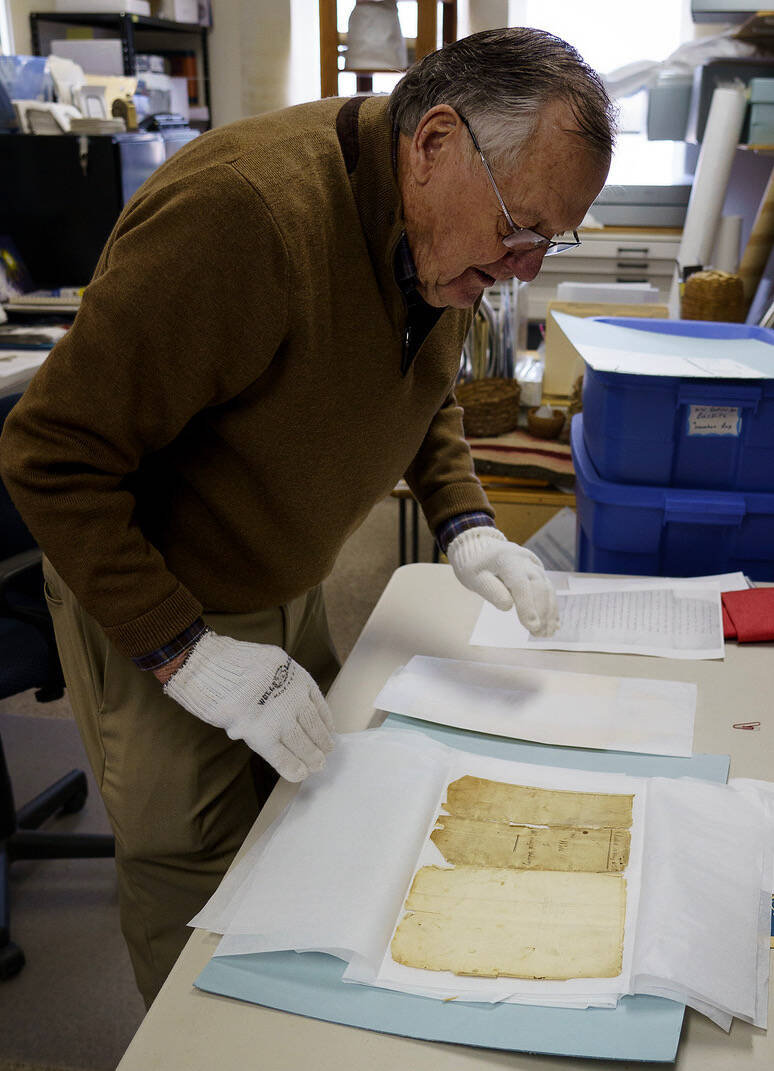While sifting through his late father’s belongings, Curt Leach discovered something extraordinary.
Tucked away inside a house in Mazon, Illinois was the will of Joseph Whidbey, the sailing master who in 1792 became the first known European to circumnavigate the Pacific Northwest island that now bears his name.
Although Leach had known of the document’s existence for several years, he was shocked to learn that it was the will of the famous naval explorer.
“Honestly, I was going to have a garage sale,” he said. “I got to going through the drawers and said, ‘Here’s that will.’”
With the help of a friend, Leach reached out to the South Whidbey Historical Society President William Haroldson about taking the will, which dates back to May 13, 1833.
“The next thing I know, it came in the mail,” Haroldson said.
The will’s appearance is no doubt a thrilling discovery for Haroldson, who has been studying the history of Joseph Whidbey for the past 20 years. But how the document got to Illinois from England, where Whidbey died in 1833, remains a mystery.
“Where that thing came from or how it got here, I don’t know,” Leach said. “It was just a man’s name in a will. That’s all I knew.”
His father, who passed away 35 years ago, liked to go to auctions and sales to collect old stuff. Leach is turning 80 soon and wanted to make sure the historic document found a new home where its significance could be appreciated.
Whidbey was a lieutenant who accompanied George Vancouver on his journey to explore the western coast of northwestern America. His main job was to collect the data needed to make charts. Between May 29 and June 8 in 1792, Whidbey sailed all the way around the island that Vancouver decided to name after him.
Whidbey didn’t spend much time around his namesake. According to historical recollection, he thought the central part of the island was beautiful, like a park. In a letter, he wrote that prisoners from England should be sent to his namesake island instead of Australia.
Later in life, Whidbey became a civil engineer in Plymouth, England, where he built the breakwater that still stands today.
“He’s kind of an interesting person,” Haroldson said. “He never married and was a workaholic.”
Nothing, including his place of birth, is known about Whidbey’s life before the age of 24. It’s something Haroldson has been endeavoring to find out through his studies of the naval explorer.
In 2003, Haroldson obtained a copy of a portrait of Whidbey that is still displayed within the South Whidbey Historical Museum in downtown Langley today. He found the original portrait in the Institution of Civil Engineers in London.
But Whidbey’s will is not something he has ever seen, until now. Wearing cotton gloves, he turns the fragile, yellowed pages with care. Each is written in impeccable cursive, and a few pages are missing chunks in the bottom right hand corner.
From reading the will, Haroldson has learned that Whidbey gave away various sums of money to his friends. In addition, he requested that all wine, spirits and liquors be given to his servants. The only two relatives he mentioned in the will are his niece Nancy Jackson and her daughter Mary Ann Burn. To his great-niece, Whidbey bequeathed a sizable amount of money with explicit directions that the cash should not go to her husband, or anyone else she married.
High-quality digital scans of the will have been completed so far. The Langley museum is in the process of rolling out some new exhibits, which will likely include an enlarged version of the historic document for people to peruse. Haroldson plans to give a presentation about the will at some point.
Like Leach, he wonders why the will turned up in the midwestern U.S. since Whidbey died on Oct. 9, 1833 in Taunton, England. It’s possible that an Austin Renne buried in a cemetery in Mazon, Illinois could be a descendant of architect John Rennie, Whidbey’s close friend whose yacht was mentioned in the will, but the spelling of the last names differ.
“If he could have been a grandson of John Rennie Sr. or possibly the son of John Rennie Jr., who carried out the finishing of the building of the breakwater, there would have been good reason why that family may have had a copy,” Haroldson said.
One thing Haroldson can say for sure? Whidbey is spelled with an “E.” The spelling has been a source of some confusion over the years as some documents — and early years of The Record — neglected the vowel.
“I’ve been to his grave, I’ve now got his will,” he said triumphantly. “It’s got the ‘E’ in it.”
As for Leach, he’s never been to Whidbey Island, let alone Washington state.
“The farthest west I’ve been is Oklahoma,” he said with a laugh.
He feels relieved, after finding a final resting place for Whidbey’s will.
“I think I found a good home for it, hopefully for more than another 50 years,” he quipped.



